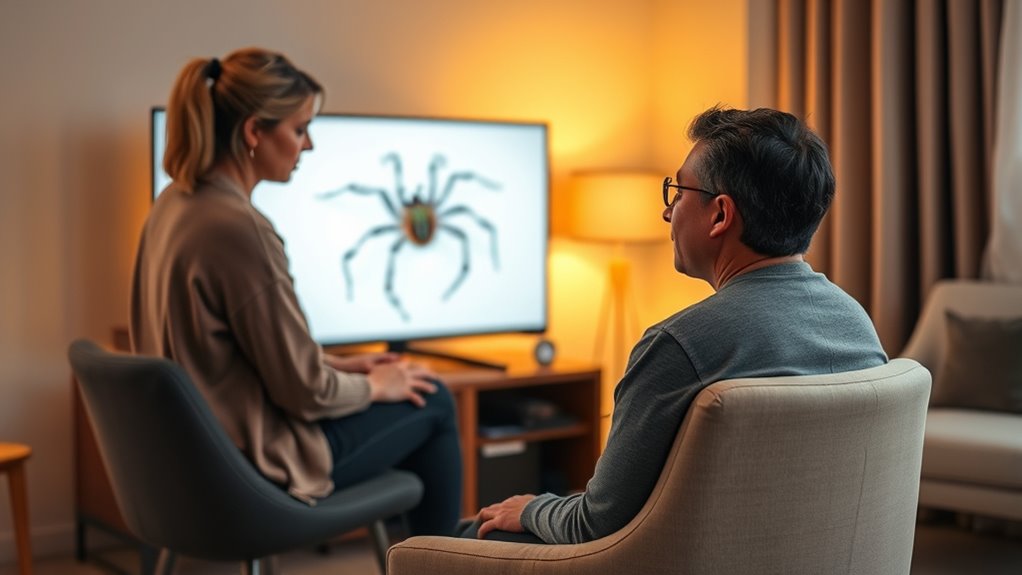Exposure therapy works by helping you weaken fear responses through mechanisms like extinction learning, where you form new safe associations, and memory reconsolidation, which allows you to modify fearful memories. Your brain undergoes neural changes, strengthening pathways that promote calmness. Gradual exposure helps you habituate to fear-provoking stimuli, while individual and environmental factors influence how effective your treatment will be. Keep exploring to discover how these processes come together to reduce your fears.
Key Takeaways
- Exposure therapy reduces fear by pairing stimuli with safety, promoting extinction learning within specific contexts.
- Revisiting fear memories triggers destabilization, allowing for modification during the reconsolidation window.
- Neural plasticity supports rewiring of fear circuits, decreasing amygdala activity and enhancing prefrontal regulation.
- Gradual, hierarchical exposure fosters habituation, decreasing sensitivity through repeated confrontation.
- Individual differences and environmental factors influence therapy success, requiring tailored approaches for optimal outcomes.
The Role of Extinction Learning in Exposure Therapy

Extinction learning is a fundamental process in exposure therapy that helps reduce maladaptive fear responses. It relies on contextual learning, where you learn to associate the feared stimulus with safety rather than danger, in a different context from the original threat. During this process, emotional processing plays a critical role, as you confront your fears while managing emotional responses. By repeatedly facing the feared object or situation without negative consequences, your brain gradually updates its threat assessment. This learning occurs within specific environmental contexts, which can influence how well the fear reduction generalizes. Basically, extinction learning helps you build new, healthier associations with previously feared stimuli, leading to decreased fear and anxiety over time. Additionally, the effectiveness of extinction learning can be influenced by the contrast ratio, which affects how clearly the new, safe associations are perceived against the background of previous fear memories. Moreover, factors such as contextual factors can either facilitate or hinder the generalization of extinction learning across different settings. Recent research suggests that neurobiological mechanisms also play a role in how extinction learning consolidates and persists over time.
How Memory Reconsolidation Affects Fear Reduction

Memory reconsolidation is a process that can profoundly influence fear reduction after exposure therapy. When you revisit a fear memory, it becomes temporarily destabilized through memory destabilization, making it open to modification. During this window, reconsolidation interference can occur if you introduce new, non-fearful information or experiences. This interference weakens the original fear memory, reducing its emotional impact. Fundamentally, by targeting the memory during reconsolidation, you can alter its emotional strength more effectively than through extinction alone. This process offers a promising approach to enhance therapy outcomes, especially for persistent or traumatic fears. Understanding how memory destabilization and reconsolidation interference operate helps explain why some exposure sessions produce long-lasting fear reduction. Research‑driven articles and ongoing studies continue to expand our understanding of these mechanisms. Additionally, the timing and nature of interventions during the reconsolidation window are critical for maximizing fear attenuation timing of interventions. Recognizing the role of **memory destabilization** in this process emphasizes the importance of precisely timed interventions for effective fear reduction.
Neural Changes Underpinning Therapeutic Outcomes

Understanding the neural changes that occur during exposure therapy reveals how the brain adapts to reduce fear. Your brain exhibits neural plasticity, allowing it to rewire circuits involved in fear and emotional regulation. This process helps weaken the overactive amygdala, responsible for fear responses, while strengthening prefrontal cortex connections that promote control. Specifically:
- Neural pathways linked to fear become less reactive over time.
- Emotional regulation improves as the brain enhances its capacity to manage distress.
- Synaptic connections supporting adaptive responses are reinforced, fostering long-term change.
- Resources and tools such as neuroimaging techniques can be employed to monitor neural changes during therapy, ensuring optimal treatment adjustments.
These changes enable you to better regulate emotions and diminish fear, leading to more resilient mental health outcomes. By understanding these neural mechanisms, you see how exposure therapy promotes lasting rewiring of your brain, supporting recovery from phobias and PTSD.
The Process of Gradual Exposure and Habituation

Gradual exposure is a core component of effective therapy, guiding you step-by-step to confront feared stimuli in a manageable way. Using a hierarchical approach, you begin with less anxiety-provoking situations and gradually progress to more challenging ones. This method helps you build confidence and reduce fear over time. Sensory exposure plays a key role, allowing you to focus on specific sensations associated with your fear, which promotes habituation. As you repeatedly confront these stimuli, your nervous system learns to downregulate its response, decreasing your anxiety. This process of habituation involves your brain becoming less sensitive to the feared stimulus through repeated, controlled exposure. Additionally, understanding the psychological mechanisms behind habituation can enhance the effectiveness of exposure therapy by fostering greater insight into your emotional responses. Recognizing the neural pathways involved in fear responses can help tailor more effective treatment strategies. Furthermore, recent advances in neural imaging techniques provide valuable insights into how these pathways change over time during therapy. Over time, your fear response diminishes, making real-world encounters less overwhelming and more manageable.
Factors Influencing Treatment Effectiveness

Several factors can influence how effective exposure therapy is for you. First, your individual differences, like personality, motivation, and trauma history, play a significant role in your response. Vetted information suggests that understanding your unique characteristics can help optimize treatment strategies. Second, the environmental context matters; a supportive, safe setting enhances progress, while an unpredictable environment can hinder it. Third, your level of engagement and willingness to face feared stimuli directly impact outcomes. If you’re more open and committed, therapy tends to be more successful. Recognizing these factors helps tailor your treatment, making it more effective. Addressing personal traits and environmental influences can boost your confidence and resilience throughout the process. Additionally, understanding relationship dynamics can improve your ability to navigate emotional challenges during therapy. Moreover, awareness of technology’s role in mental health can inform your approach and expectations during treatment. Ultimately, understanding these factors empowers you to actively participate and maximize the benefits of exposure therapy.
Frequently Asked Questions
How Does Exposure Therapy Compare to Medication for Treating Phobias?
When comparing exposure therapy to medication for phobias, you’ll find that exposure therapy often offers better long-term therapy efficacy without medication side effects like drowsiness or dependency. While medication may reduce symptoms quickly, it might not address underlying fears. Exposure therapy actively helps you confront fears, leading to lasting change. You might prefer it if you want a treatment with fewer side effects and stronger, sustained results.
Can Exposure Therapy Be Effective for Complex PTSD Cases?
Imagine steering through a complex maze, where every turn reveals new challenges. That’s what treating complex PTSD feels like, but exposure therapy can still help. While comorbidity considerations require careful treatment customization, exposure therapy can be effective if tailored to individual needs. You might face more hurdles, but with a skilled approach, confronting traumatic memories gradually can foster healing and resilience.
What Are Common Challenges Faced During Exposure Therapy Sessions?
During exposure therapy sessions, you might face common challenges like patient resistance, where clients hesitate or avoid confronting fears, and emotional flooding, which occurs when intense feelings overwhelm the individual. These issues can hinder progress, so you need to establish trust, maintain a gradual approach, and provide support. Addressing resistance and managing flooding guarantees the therapy remains effective and helps clients build resilience over time.
How Long Does It Typically Take to See Significant Improvement?
You might wonder how long it takes to see significant improvement. Usually, treatment duration varies depending on individual factors, but many people notice progress within a few sessions. The recovery timeline can range from weeks to months, with consistent exposure therapy sessions helping reduce anxiety. Patience is key, and sticking with the process often leads to meaningful change, even if results aren’t immediate.
Are There Any Risks or Potential Setbacks in Exposure Therapy?
You should be aware that exposure therapy can have side effects like increased anxiety or emotional distress during sessions. While rare, some people experience setbacks or relapse risks if they haven’t fully processed their fears or if they stop treatment prematurely. However, working closely with your therapist can help manage these risks, ensuring you’re supported through the process and reducing the chances of setbacks or lingering side effects.
Conclusion
As you navigate exposure therapy, imagine a path through a storm—each step gradually calming the thunder and lightning. With patience, your fears fade like shadows at dawn, replaced by newfound strength. Your brain rewires, forging new pathways that diminish old fears. Embrace each exposure as a step toward freedom, knowing that with time and persistence, the storm within you will clear, revealing a brighter, calmer horizon ahead.









